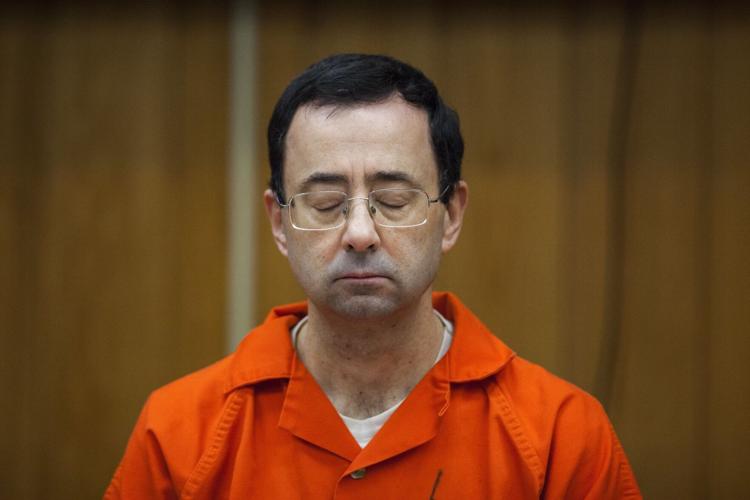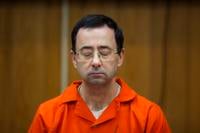Investigators probing disgraced former sports doctor Larry Nassar’s stabbing Sunday at a federal penitentiary in Florida are lacking a key piece of evidence: video of the assault.
Nassar was attacked inside his cell, a blind spot for prison surveillance cameras that only record common areas and corridors, a person familiar with the matter told The Associated Press. In federal prison parlance, because of the lack of video, it is known as an "unwitnessed event."
It's the second time Nassar, the former U.S. women’s gymnastics team doctor, has been assaulted in federal custody while he's serving decades in prison for sexually abusing athletes and possessing explicit images of children.
The attack, which left Nassar hospitalized in stable condition with injuries including a collapsed lung, underscored persistent problems at the federal Bureau of Prisons.
Despite the Biden administration's vow to fix the broken prison system — with new leadership and an emphasis on turning prisoners into “good neighbors” — the agency has continued to struggle with violence, understaffing, abuse and misconduct.
Nassar's stabbing, just weeks after “Unabomber” Ted Kaczynski's suicide at a North Carolina federal medical center and amid lingering fallout from Jeffrey Epstein's 2019 jail suicide, also highlighted the agency's inability to keep even its highest profile prisoners safe.
“This kind of violence in our federal prisons is inexcusable,” said Daniel Landsman, the deputy director of policy at the criminal justice advocacy group FAMM, or Families Against Mandatory Minimums. “The failures that led to this assault are not isolated — too often we see similar incidents impact incarcerated people across the country."
“The assault of Larry Nassar raises a number of questions regarding safety in in federal prisons,” Landsman said.
The Bureau of Prisons did not respond Tuesday to AP's questions about Nassar’s stabbing, and violence, low staffing levels and other problems plaguing its facilities. In a statement Monday, the agency confirmed an altercation involving an inmate at the United States Penitentiary Coleman, but declined to identify the person “for privacy, safety and security reasons.”
Nassar, 59, was attacked inside his cell Sunday by a prisoner armed with a makeshift weapon, according to the person familiar with the matter. Nassar was stabbed multiple times in the neck, chest and back. Two officers guarding the unit where Nassar was held were working mandated overtime shifts because of staffing shortages, the person said.
The person was not authorized to publicly discuss details of the attack or the ongoing investigation and did so on condition anonymity.
Nassar was previously assaulted in May 2018 at a federal prison in Tucson, Arizona, within hours of being placed in general population — an attack his lawyers blamed on the notoriety of his case and a seven-day televised sentencing where scores of victims made impassioned statements. Nassar's lawyers did not specify the nature or severity of that attack.
Cell doors on most federal prison units are typically open during the day, letting prisoners move around freely within the facility. Surveillance cameras aren’t positioned to see inside cells, though other cameras may have captured Nassar’s assailant walking in and out of the cell.
At some federal prison facilities, including the Manhattan jail where Epstein died, surveillance cameras been found to malfunction or not record at all — an issue Sen. Jon Ossoff, D-Ga., sought to address last December with a law requiring the Bureau of Prisons to overhaul failing and outdated security systems. The agency, however, has been slow to make progress.
Facing increased scrutiny in the wake of Epstein's suicide and an ongoing AP investigation that has uncovered myriad scandals, Bureau of Prisons Director Colette Peters has pledged to overhaul recruiting and hiring practices and end systemic abuse and corruption.
But changing the culture of the massive agency — the Justice Department’s largest with more than 30,000 employees, 158,000 inmates and an annual budget of about $8 billion — has proved exceedingly difficult. Correctional workers say they've seen no meaningful reforms to fix longtime staffing problems that put inmates' and their own lives at risk.
Just two weeks before Nassar's stabbing, workers at the Florida prison complex where he was attacked organized a protest outside a nearby supermarket to highlight what they said were dangerous staffing levels.
“They’re going to have somebody killed, either staff or an inmate, if they don’t fix the problem,” said Jose Rojas, the union president at the Coleman prison complex. “We sounded the alarm, we warned the public, and I hate to be prophetic, but we were right.”
At Nassar's prison, known as USP Coleman II, nearly one-quarter of correctional officer positions are vacant, according to records obtained by AP. Staffing guidelines show the facility, with more than 1,200 prisoners, should have 222 correctional officers. Only 169 positions are filled.
The day Nassar was stabbed, 44 posts were left vacant and unassigned at the prison, records show. One of the officers assigned to Nassar’s unit was working a third straight 16-hour day, while the other officer was on a second straight day of mandated overtime.
The AP has revealed widespread criminal conduct by employees, sexual abuse by workers, inmate escapes, and staffing shortages that have hampered responses to emergencies.
Last August, the Justice Department appointed Peters — a reformer who previously ran Oregon’s state prison system — to replace former Bureau of Prisons Director Michael Carvajal, a Trump administration holdover who clashed with Congress, claimed staffing wasn’t problematic and had to be subpoenaed before attending one of his last oversight hearings.
Peters, in turn, has focused on shifting the Bureau of Prisons away from its strictly carceral roots, emphasizing that “our job is to make good neighbors, not good inmates.” Peters has rewritten the agency’s mission statement to emphasize employees' job to “foster a humane and secure environment and ensure public safety" by preparing people behind bars for successful reentry into their communities.
Associated Press reporter Alanna Durkin Richer contributed to this report.
The Associated Press receives support from the Public Welfare Foundation for reporting focused on criminal justice. The AP is solely responsible for all content.
On Twitter, follow Michael Sisak at http://twitter.com/mikesisak and Michael Balsamo at http://twitter.com/MikeBalsamo1 and send confidential tips by visiting https://www.ap.org/tips/














